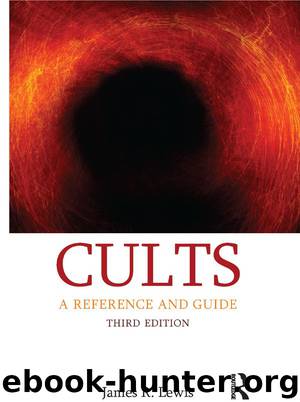Cults by Lewis James R

Author:Lewis, James R.
Language: eng
Format: epub
ISBN: 9781317545125
Publisher: Taylor and Francis
Published: 2014-09-11T04:00:00+00:00
CHAPTER 4
DOCUMENTS AND DATA
STATISTICS
General estimates of the extent of the New Religions phenomenon vary considerably. The two basic quantitative questions in this area are: How many groups? And, How many people? These questions are not as simple as they might at first appear. A more fundamental question involves classification: Where does one draw the line between alternative and non-alternative religions? What one finds when one actually tries to determine where to draw such a line is that the difference between “mainstream” and “alternative” is a matter of degree rather than a sharply defined distinction.
The indeterminacy of this dividing line allows anti-cultists like the late Margaret Singer to assert, without fear of direct contradiction, that as many as 20 million people have been involved in three to five thousand cults in the United States (Singer and Lalich 1995). In contrast, Gordon Melton estimates five to six hundred alternative religions in the United States (Melton 1992). Similarly, Peter Clarke estimates four to five hundred new religions in the United Kingdom (Clarke 1984). The situation is rather different in Japan, where New Religions have been thriving since the end of the Second World War. Japanese sociologists estimate anywhere from eight hundred to several thousand (Arweck 2001) such groups. And finally, Eileen Barker puts forward a figure of two thousand or more New Religions in the West, and a figure in the lower tens of thousands worldwide (Barker 1999).
An important though neglected source of information bearing on the question of numbers of adherents to alternative religions is national census data. In 2001, the censuses of four English-speaking countries—New Zealand, Australia, Canada, and the United Kingdom—collected information on religious membership that included select New Religions. There was also an important religion survey conducted in the United States in the same year, the American Religious Identification Survey (ARIS). Additionally, New Zealand and Australia collected religion affiliation data in 2006, and the ARIS in 2008.
Though a few scholars of New Religions have referred to one or more of these censuses, no one has attempted a general survey. Following an examination of one estimate of world religious adherents, the first part of this chapter discusses census data and information from the ARIS survey that shed light on participation rates in alternative religions. Select studies that measure other dimensions of the New Religions phenomenon will also be examined.
The second part of the chapter reproduces four documents that will provide a more tangible sense of the controversy. Two are documents left in the wake of the suicides of the Order of the Solar Temple and of Heaven’s Gate. The other two are texts of legislation enacted against controversial religions, one from China and the other from France.
Download
This site does not store any files on its server. We only index and link to content provided by other sites. Please contact the content providers to delete copyright contents if any and email us, we'll remove relevant links or contents immediately.
The Four Agreements by Don Miguel Ruiz(6563)
Breaking Free by Rachel Jeffs(4130)
The Hatha Yoga Pradipika (Translated) by Svatmarama(3196)
120 Days of Sodom by Marquis de Sade(3136)
Member of the Family by Dianne Lake(2287)
The Tao of Physics by Fritjof Capra(2214)
The Psychedelic Gospels: The Secret History of Hallucinogens in Christianity by Jerry B. Brown(2106)
The Road to Jonestown by Jeff Guinn(2005)
Going Clear: Scientology, Hollywood, and the Prison of Belief by Lawrence Wright(1919)
Going Clear by Lawrence Wright(1907)
Uriel's Machine by Christopher Knight(1850)
The Grand Grimoire: The Red Dragon by Author Unknown(1743)
The Gnostic Gospel of St. Thomas by Tau Malachi(1721)
Key to the Sacred Pattern: The Untold Story of Rennes-le-Chateau by Henry Lincoln(1582)
The Malloreon: Book 02 - King of the Murgos by David Eddings(1543)
Waco by David Thibodeau & Leon Whiteson & Aviva Layton(1514)
The New World Order Book by Nick Redfern(1512)
The Secret of the Temple by John Michael Greer(1451)
Animal Speak by Ted Andrews(1447)
